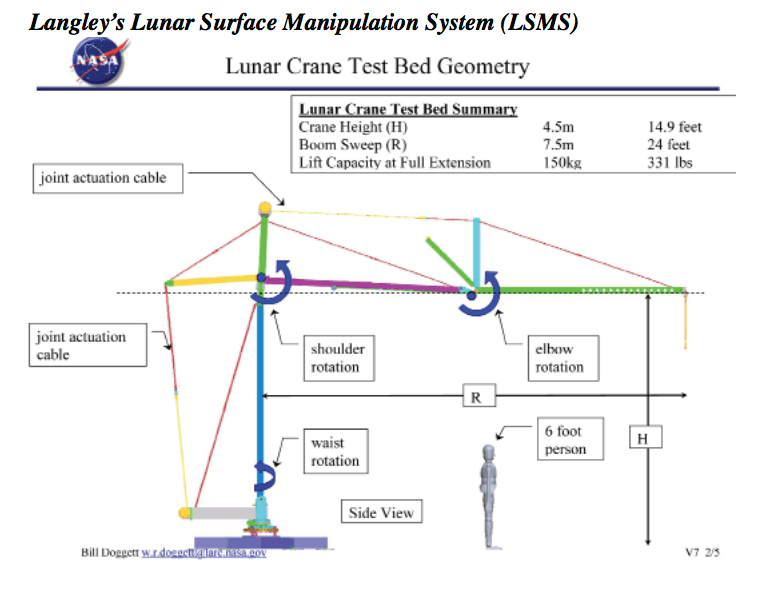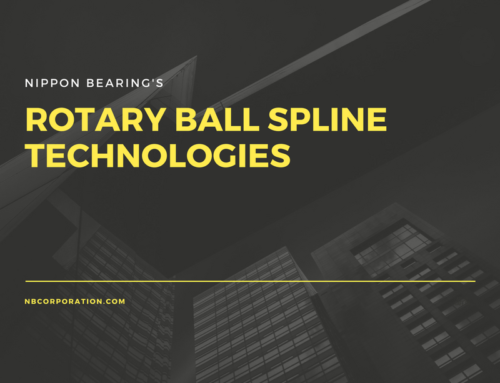Manned Or Not, This Lunar Project Has A Prototype
When NASA Langley Research Center hired Honeybee Robotics Spacecraft Mechanisms Corporation to develop a totally mechanical tool changer, Honeybee was ready.
The tool changer was for the end of what Langley’s Lunar Surface Manipulation System (LSMS) team describes as a robot that could unload landers. Then, after the landers were unloaded, it could, in addition to doing base assembly, mate with tools to take science experiments. This robot could be likened to a crane but with more dexterity.
The crane was designed to work remotely so that it could be used on an unmanned mission without human interaction. It’s completely autonomous. That’s one of the driving factors. And the tool changer does have other applications if they decide they want to use it on Mars or even in outer space for a robotic arm and end effectors.
Since Honeybee has been developing harsh-environment, mission-critical end-effectors for over 25 years and has worked on the equipment for other space missions, they were specially suited to tackle this challenge.

Making It Work
Basically, Honeybee was given an envelope – a footprint to stay within – and all the requirements for load ratings and misalignment allowances.
Lee Carlson, a Systems Engineer who was part of the Honeybee team, describes the project, “The crane might be sitting on the lander deck or on the lunar surface and would be driven from quite a distance away from the tool to be mated to; this required designing for large misalignment allowances … this was our first design challenge. The end of the crane and target tool could be misaligned by as much as a couple inches in any direction with up to 20 degrees angular misalignment when attempting a mate.”
But, Carlson continues, there were other considerations too. “The tool changer had to be capable of carrying around 1000 lbs so (the tool changer) had to be very robust. Also, since this was a lunar project, it has to be tolerant to moon dust. These two design criteria required special seals to protect large roller bearings. If this design was for space it becomes considerably simpler. All of the loads would be reduced and dust is no longer an issue. But the moon is a very harsh environment and lunar dust is a major concern when designing for missions there.”
When NASA Had An ‘Afterthought’, Honeybee Engineers Had A Real Challenge
The original assignment called for ‘dummy’ tools requiring no power. The crane would do all the work. Tools would range from a fork lift attachment, a shovel or scoop for acquiring surface samples or digging, or even a bucket for lifting human passengers.
Then NASA decided it wanted the capability of attaching an electronic or electromechanical tool to the end of the crane. Now the tool changer would have to provide an electrical connection as well. Solving this problem fell to Carlson, “The contract was expanded to add an electrical connector to the existing mechanical connector. You’d have a power source on the LSMS, on the crane itself. Your tools could then be powered. So your tools capabilities could expand into the realm of cameras or tools with cameras on them or even a light jackhammer.” However, they had not left space to accommodate an electrical connector because it was not a part of the original contract and the budget did not allow for starting from scratch.
The Crucial Ten Square Inches
Carlson had to work within the constraints of the current design because NASA did not want a redesign of the whole tool changer. They just wanted to add an electrical connector to it without increasing the current envelope. He only had roughly two and a half by four inches of free space to incorporate the male side of the new autonomous connector. The connector has to mate itself to a female connector mounted on the tool. Carlson says, “We make small stuff all the time and if there were more space, there are many different ways that I could have designed it.”
“This is, probably, the most compact I’ve ever had to make anything.”
Honeybee designed both the male and female sides of the connector. The female side had to be inexpensive and easy to create because each tool would have to have its own female connector versus a single male connector attached to the crane. The female connector has no moving parts but is slightly compliant.
The male connector has all the moving parts. It is cylindrical and populated with eleven 1/16” diameter aluminum pins which are plated with gold over nickel configured in a standard MIL/Spec pattern. The connector rides on compact slides – miniature guides made by NB Corporation. They are called SEBS. The top faces of the two glides are facing each other and Honeybee’s components are in between the two glides – supporting this connector. This configuration reduces the moment loads on the slides.
Precise Movements
Lee Carlson describes how it works, “We actually used a total of six slides within the space – three on each side. The slides ride on each other in the manner of drawer slides that are stacked to extend the distance they can open a drawer. Our configuration achieves an extension of the movement equal, approximately, to the length of 3 slides. So instead of a half-inch stroke, we could get an inch and a half stroke – within a very, very small footprint. Low mass, low load and very low profile were all required for this application.”
Carlson says that the reason that they chose these particular guides was that they were some of the smallest slides that he could find. His one caveat was that he wanted to work with one of the slide suppliers that Honeybee had worked with before – not take chances on a new supplier. It also had to be a guide that, even though this was a prototype, was completely made of stainless steel without any plastics. Plastics are generally avoided unless they are specially chosen and approved. As for lunar dust tolerance, the whole electrical connector assemblage will be sealed in a bellows to protect it from the harsh lunar regolith.
Honeybee was able to choose from the widest selection of miniature linear slide guides on the market. The standard SEBS guides major advantage is that they have a standard radial clearance that is twice as accurate as other standard miniature guides. Most manufactures do not claim that their preload eliminates all clearance. Their standards are plus to minus, which allows gaps, i.e. clearance, to exist. Minus means there is some preload so there’s no gap. NB’s are from zero to minus as a standard, making for greater accuracy because there is no clearance. In other words a negative clearance means the ball is larger than the space adding more pressure and greater rigidity. This increased rigidity is desirable in high precision applications. NB’s standard fabrication requires more control in the assembly and manufacturing process in order to adhere to this higher quality standard.
If A One Rail Solution Had Been Viable
Of course there can be instances where no preload is desired, where one might want to remove all friction and trade off accuracy and rigidity for minimal friction. In such a case, one might want clearance. But the space mission was not such a case.
Had a different design route been taken by Honeybee, there might have been a deformation of the guide block to consider. For instance, had the connector been mounted on only one rail on an arm that extended to the side, this would have caused deformation of the block, reducing accuracy. There is a solution to this problem. It is called the SEB-AD. The AD version is stiffer because NB optimizes the machining of the top-mounting surface of the guide block that attaches to the table. This withstands the extra moment load that could have caused some clearance due to deformation.
Wide Range Of Sizes For Tiny Guides
For the smallest applications, there is an extra compact block for lesser loads – SEBSBS (size 2), which is shorter than the standard length block and only has two holes instead of four. Either retained-ball (whose elements allow for easier handling since the guide block may be removed from rail without ball loss) or low-cost non-retained-ball lines are available.
A unique miniature guide that provides the greatest rigidity is the SER. It uses crossed-roller bearings, which give more rigidity. Crossed rollers have greater contact areas than ball bearings. SER comes in all stainless steel. It has non-retained rollers and is available in the same block sizes and configurations as the SEBS ball bearing miniature guides.
In recent tests executed by Newmark Systems, Inc. of Rancho Santa Margarita, California, due to their friction-free travel, NB’s miniature guides have proven to not wear even after one and a half years of constant travel.
Moonwork Takes Patience
As Honeybee waits to complete assembly and testing with the LSMS, they look forward to the future when, hopefully, the project will make its way to the moon – the final test of all.




